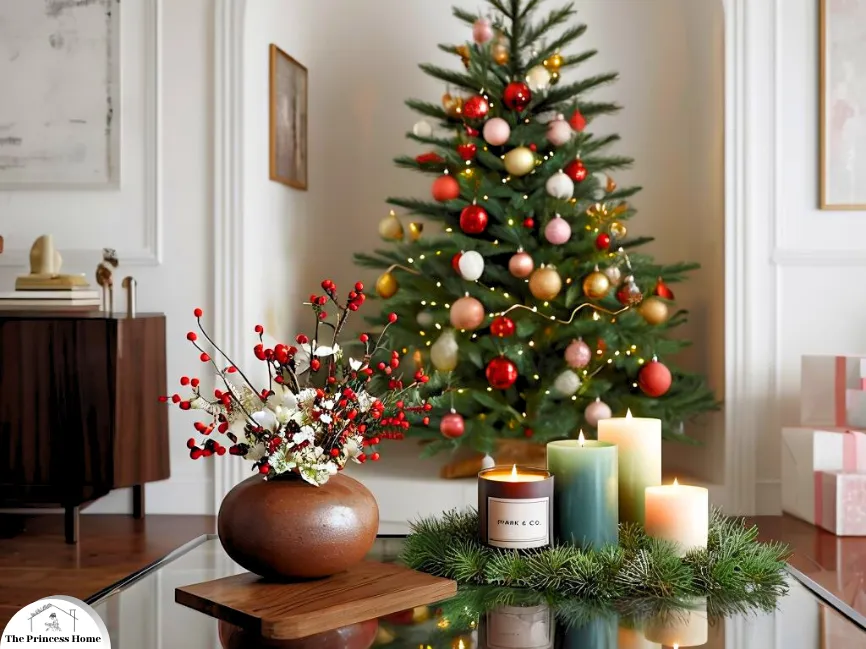
Japan Xmas: Harmonious Ideas to Blend East and West
Incorporating Japanese elements into Christmas decor can create a unique, serene, and beautifully balanced holiday aesthetic. Drawing inspiration from Japan’s minimalism, nature-inspired details, and traditional arts, this approach can add subtle elegance and peaceful ambiance to your holiday setup.
Here are some ideas to help you infuse your Christmas decorations with Japanese charm this season:
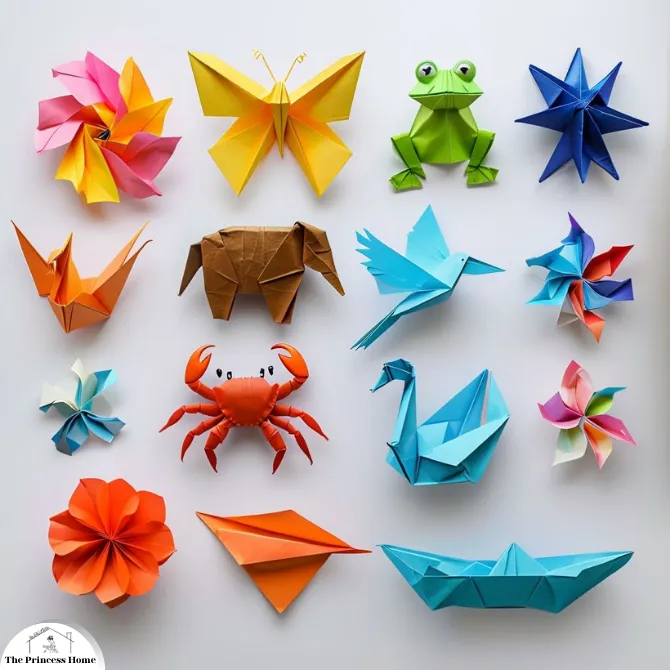
1. Origami Christmas Ornaments
Origami, the Japanese art of paper folding, can be transformed into beautiful Christmas ornaments. By using traditional Christmas colors or soft metallic papers, you can create shapes like cranes, stars, snowflakes, and even small Christmas trees. Here’s how to make them a focal point:
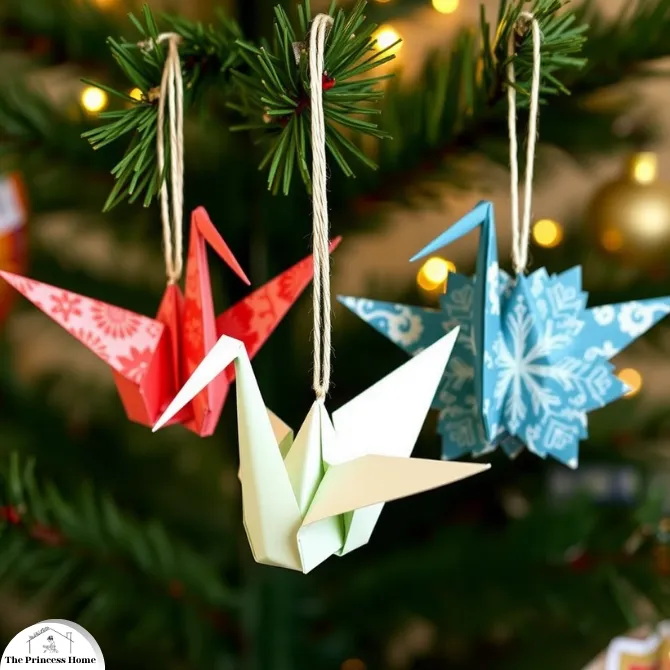
Cranes for Peace:
In Japan, cranes are symbols of peace and hope, which aligns beautifully with the Christmas spirit. Create several origami cranes and string them together to form garlands, or hang them individually from your Christmas tree branches.
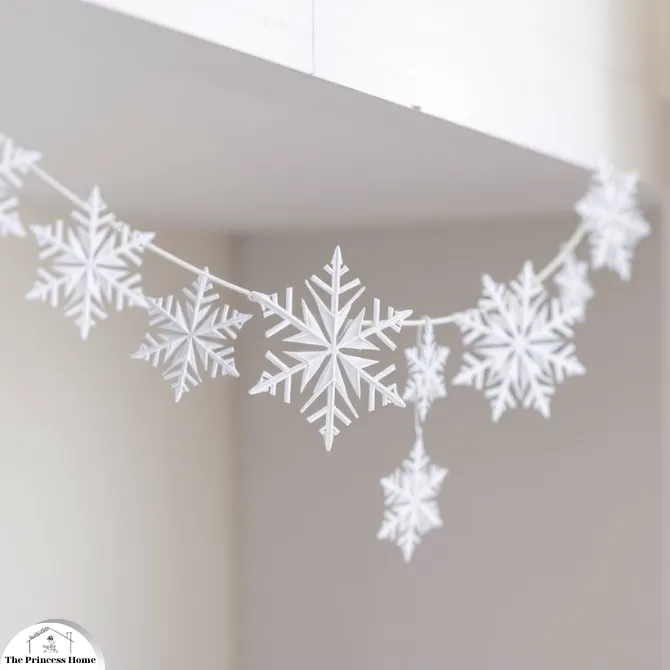
Snowflake Garland:
Try creating a garland with delicate origami snowflakes in white and silver. They’ll add a sense of winter magic and reflect the purity of freshly fallen snow.
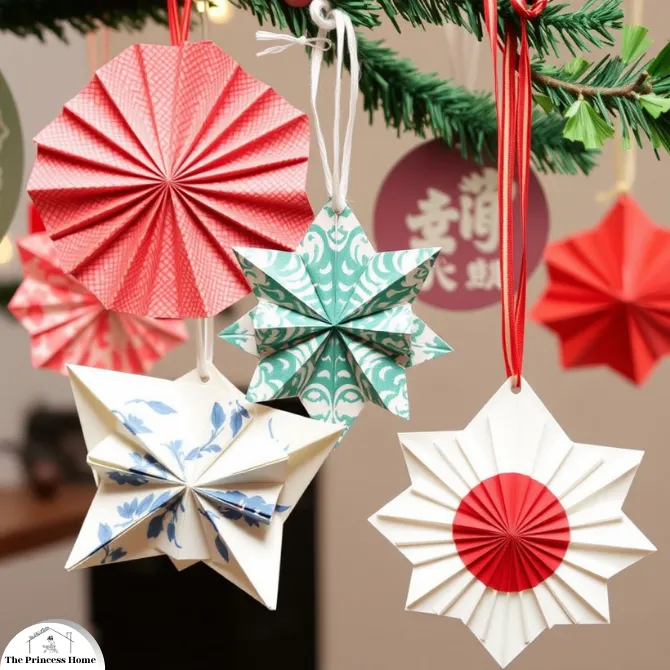
Japanese Paper Choices:
Opt for washi paper, which is traditional Japanese paper known for its unique texture and patterns, to give your origami ornaments an authentic feel.
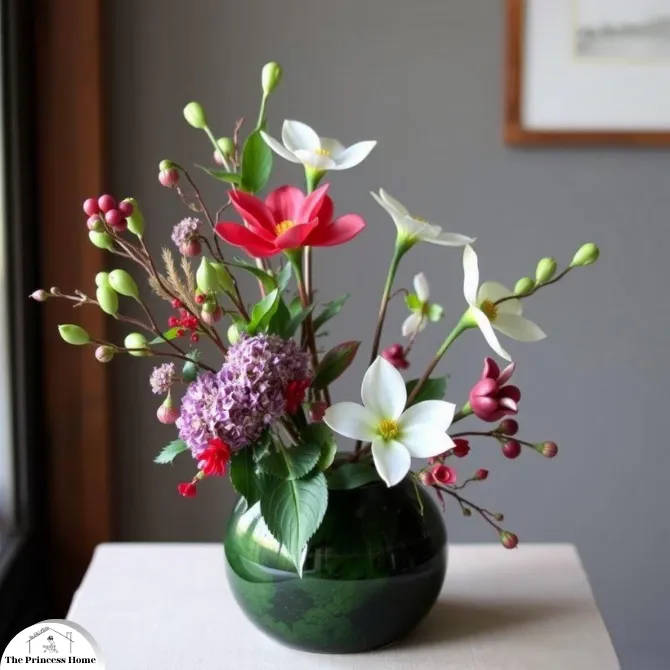
2. Ikebana-Inspired Christmas Floral Arrangements
Ikebana, the Japanese art of flower arranging, emphasizes harmony, balance, and simplicity, making it a perfect inspiration for Christmas arrangements.
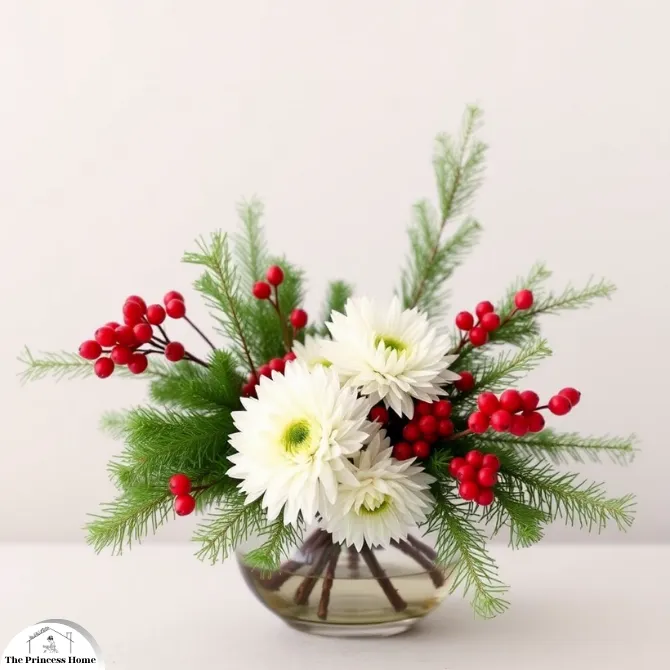
Minimalist Greenery:
Instead of a large bouquet, arrange a few carefully selected sprigs of evergreen, red berries, and maybe a few white chrysanthemums (a flower often associated with Japanese culture) in a low vase.
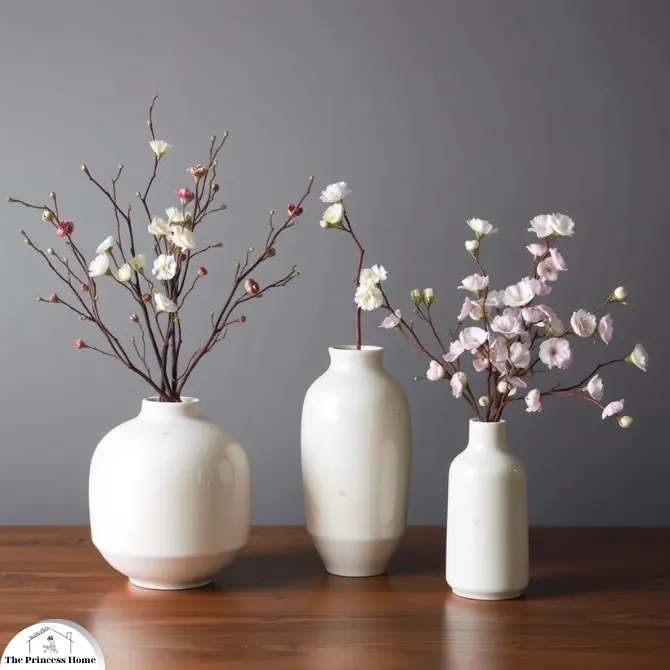
Japanese Ceramic Vessels:
Display these arrangements in minimalist Japanese ceramic or porcelain vases to capture that authentic look.
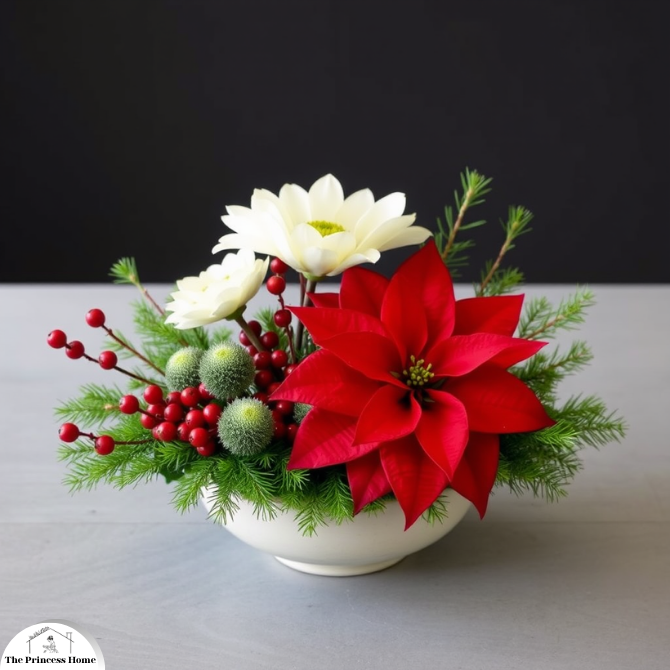
Single Bloom Focus:
Place a single poinsettia bloom or a white chrysanthemum in a small vase with a sprig of pine and holly for a look that’s restrained but festive.
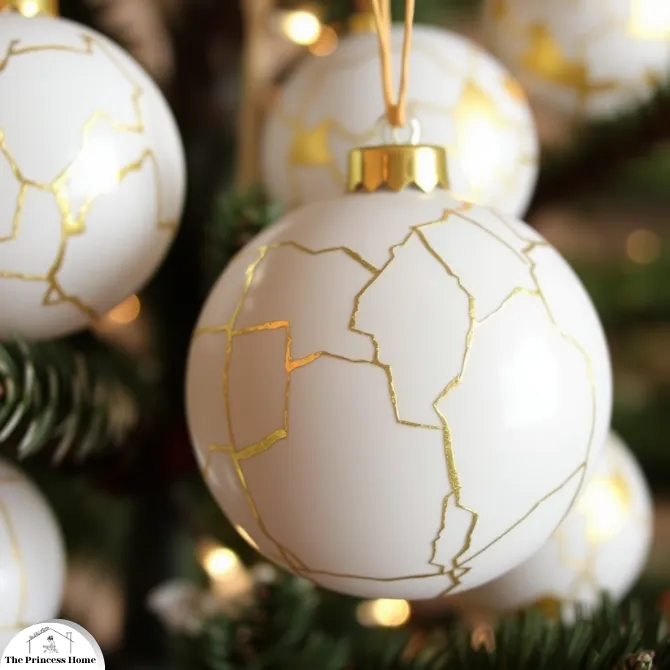
3. Kintsugi-Inspired Christmas Ornaments
Kintsugi is the Japanese art of repairing broken pottery with gold, highlighting the cracks as part of the object’s beauty. Use this concept as inspiration for Christmas ornaments with a unique flair.
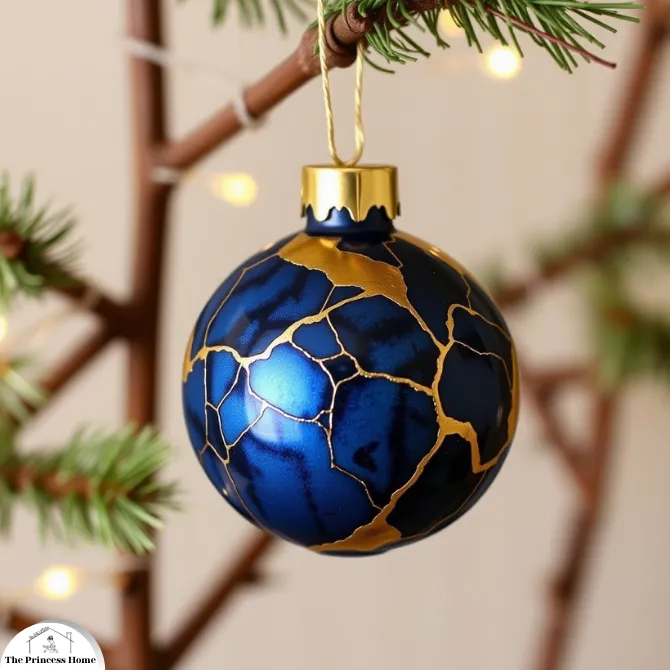
Golden Cracks:
If you have plain, round ornaments, try drawing “cracks” using gold paint or a metallic marker to resemble the Kintsugi effect.
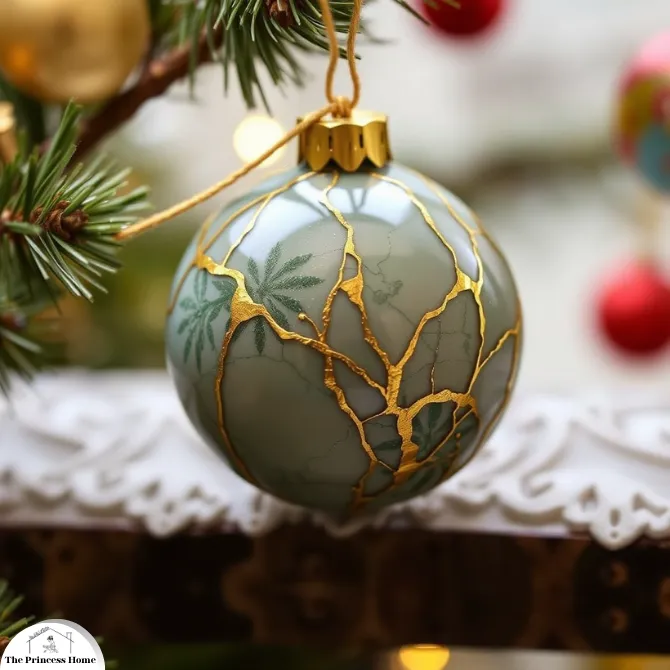
Broken Ornament Repair:
Repair any broken ornaments using this technique, adding gold glue or paint to create a truly unique, upcycled piece that celebrates imperfections. Break and then piece back together ceramic ornaments, filling the cracks with glittery gold glue, for a more authentic Kintsugi-inspired ornament.
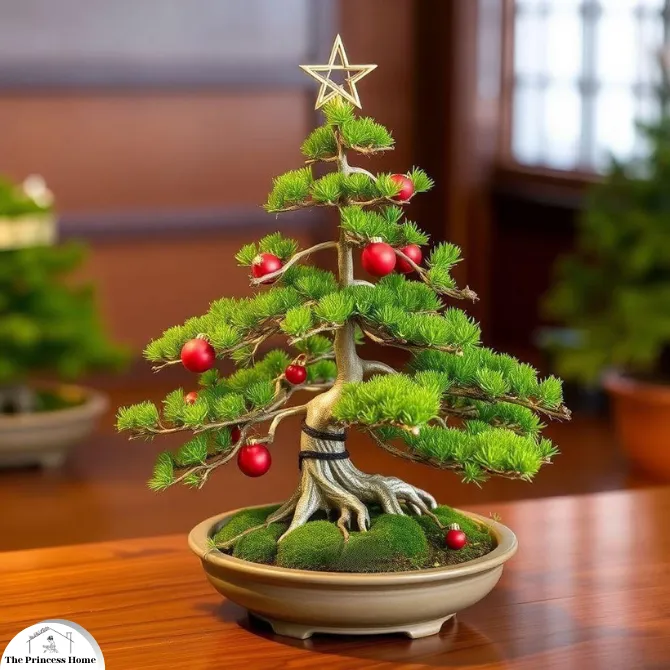
4. Bonsai Christmas Tree
For a unique twist on the traditional Christmas tree, consider a bonsai-inspired tree.
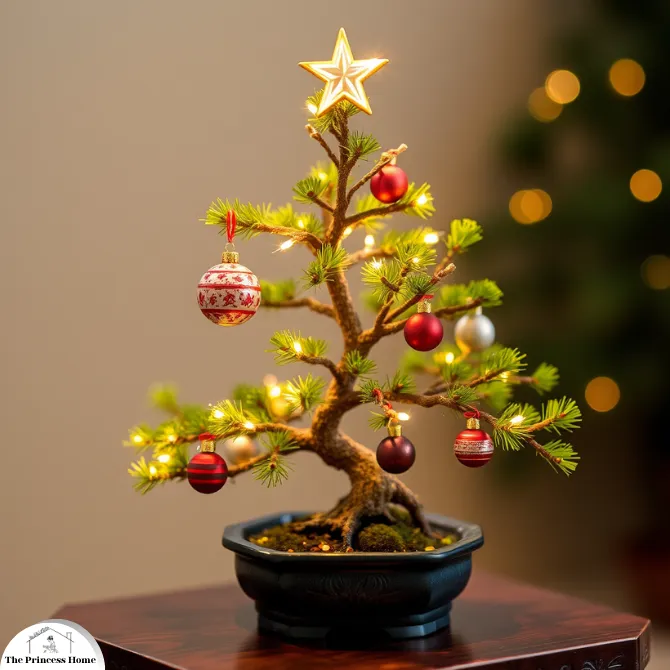
Miniature Decor:
Decorate a small bonsai tree with tiny ornaments, delicate fairy lights, or a miniature star.
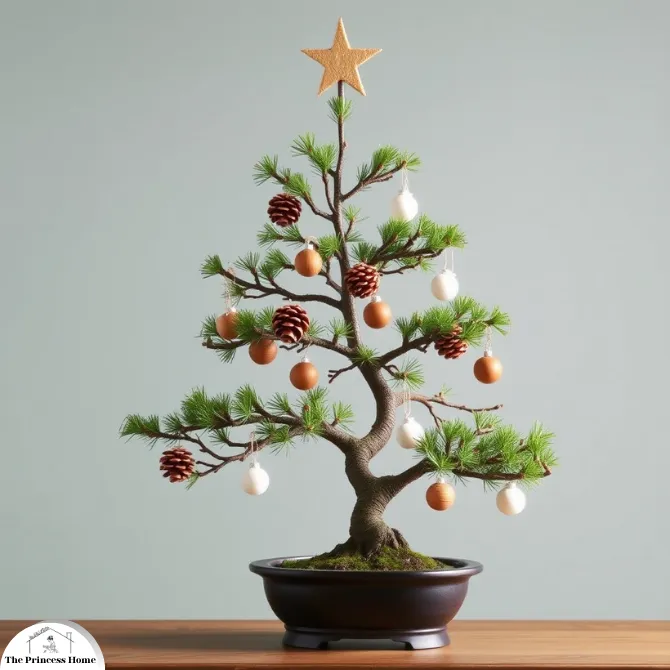
Simple Ornaments:
Use natural materials like pinecones or small pieces of driftwood, keeping the tree in harmony with the Japanese aesthetic of natural beauty.
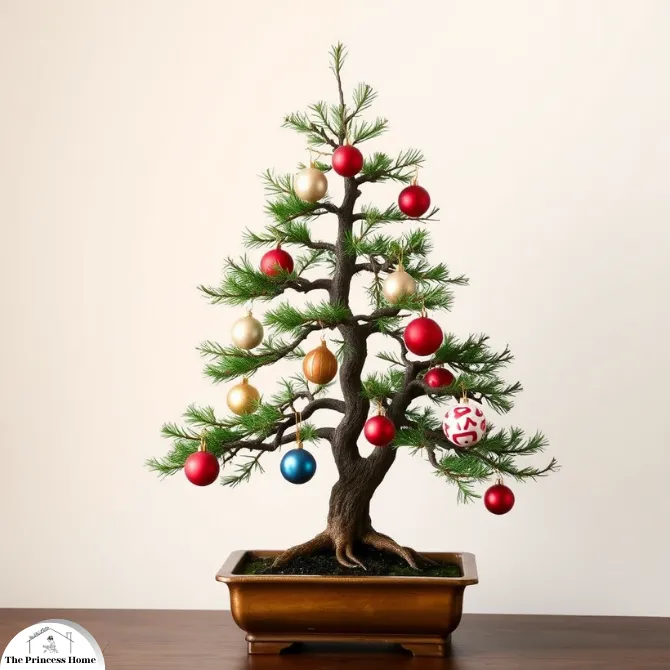
Ornament Placement:
Avoid overcrowding; Japanese aesthetics often favor open space, so place ornaments sparingly to allow the tree’s natural shape to shine.
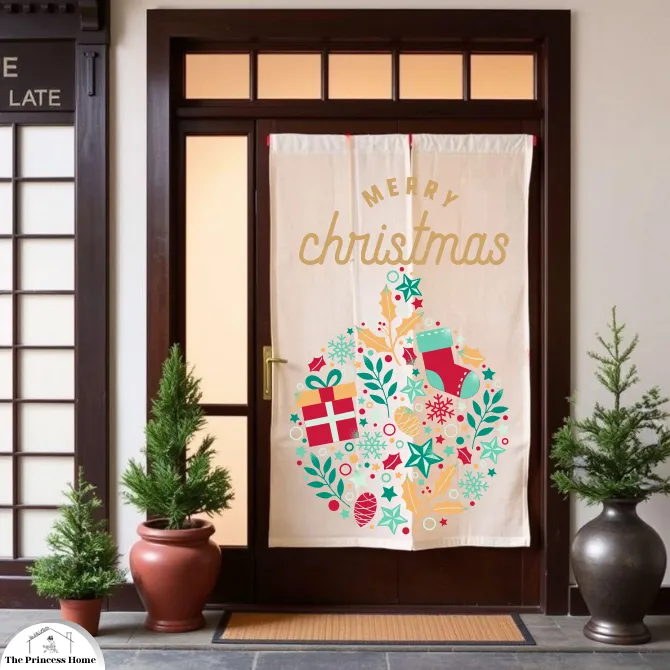
5. Noren-Inspired Doorway Decorations
Noren are traditional Japanese fabric dividers often used in doorways and windows. For a Japanese twist on Christmas decor, create a noren-inspired doorway hanging.
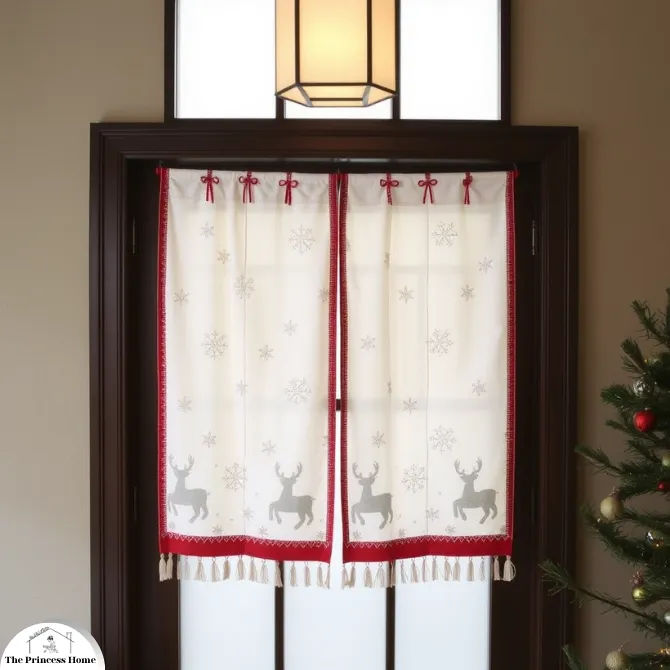
Seasonal Motifs:
Choose fabric with Christmas motifs, like snowflakes or reindeer, in subtle colors such as silver, red, or white. Use linen or cotton, which are traditional Japanese fabric choices.
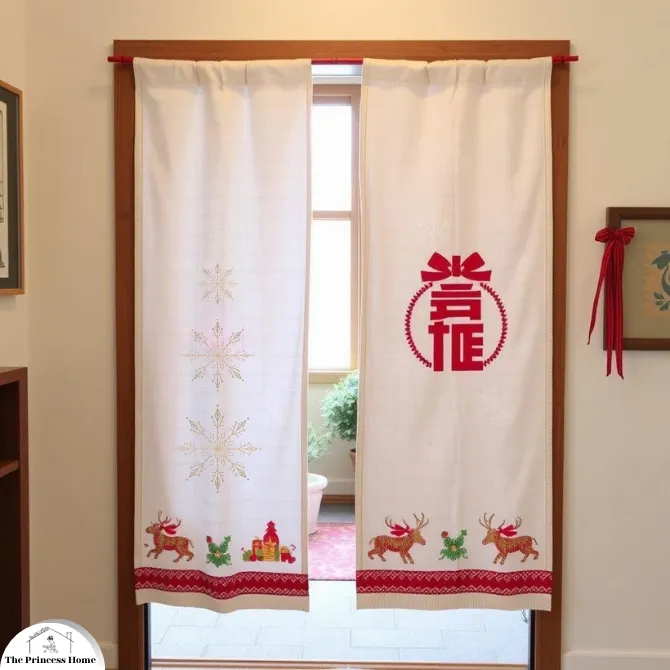
Personalization:
Add a family monogram, similar to Japanese family crests, in a Christmas theme to create a welcoming and personal touch.
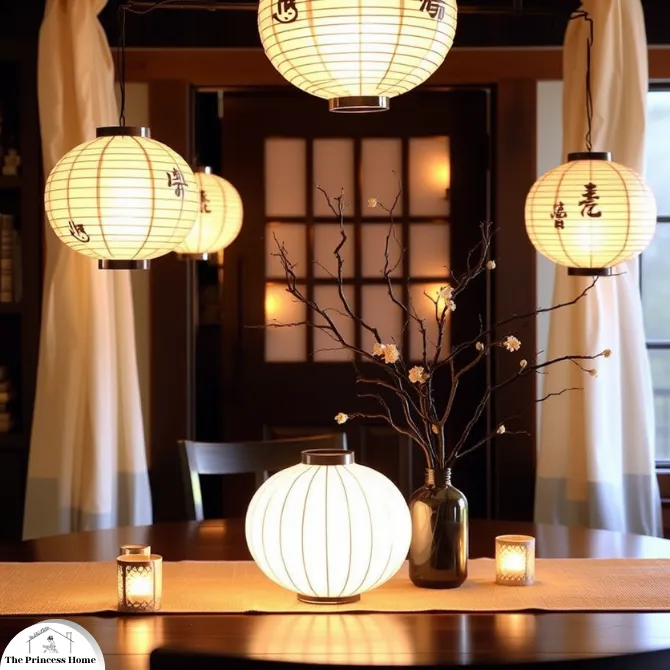
6. Japanese Paper Lanterns with Holiday Touches
Japanese paper lanterns add a soft, atmospheric glow to any room. For a Christmas twist, consider adding a holiday theme to your paper lanterns.
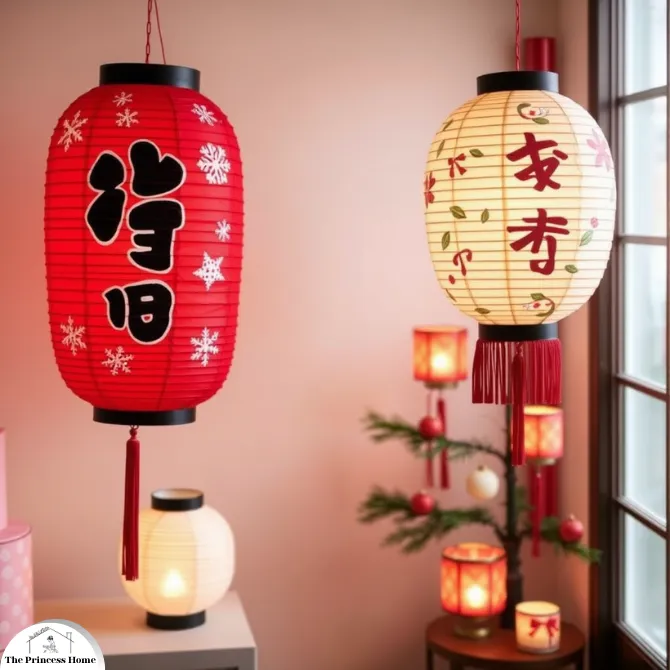
Christmas Lanterns:
Paint or stencil holiday images on paper lanterns, like snowflakes, holly leaves, or stars. Choose a red and white color scheme for lanterns to match Christmas colors while maintaining a Japanese aesthetic.

Tabletop Accents:
Use smaller paper lanterns as unique centerpieces or to frame your entryway for a magical glow that reflects both Japanese elegance and holiday spirit.
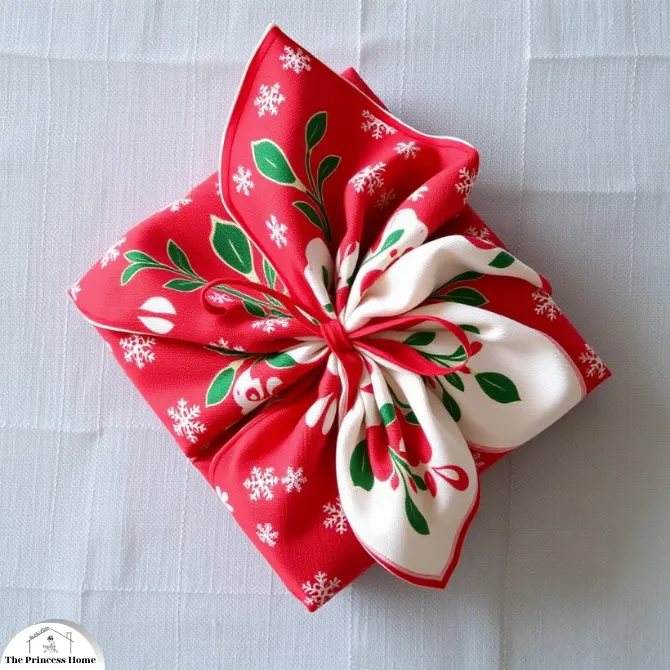
7. Furoshiki-Wrapped Christmas Gifts
Furoshiki is a traditional Japanese cloth used for wrapping gifts, food, and other items. This eco-friendly wrapping method can bring a touch of Japanese elegance to your Christmas gift wrapping.
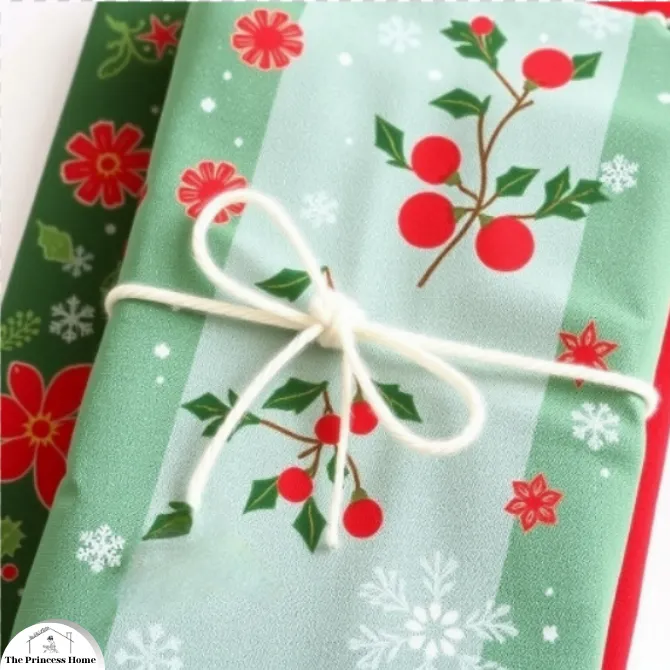
Festive Fabrics:
Choose fabrics in festive colors or patterns. Consider pairing reds, whites, and greens with small prints that evoke the Christmas spirit, like snowflakes or mistletoe.
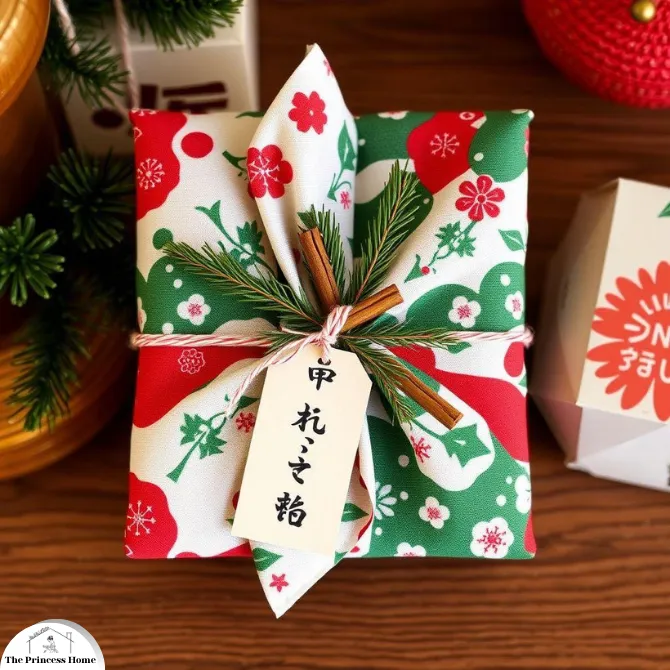
Personalized Tags:
Add a handwritten tag in Japanese calligraphy, featuring phrases like “Merry Christmas” (メリークリスマス) for a culturally immersive touch. Add small pine sprigs or cinnamon sticks to the knot for a bit of holiday fragrance and an extra decorative touch.
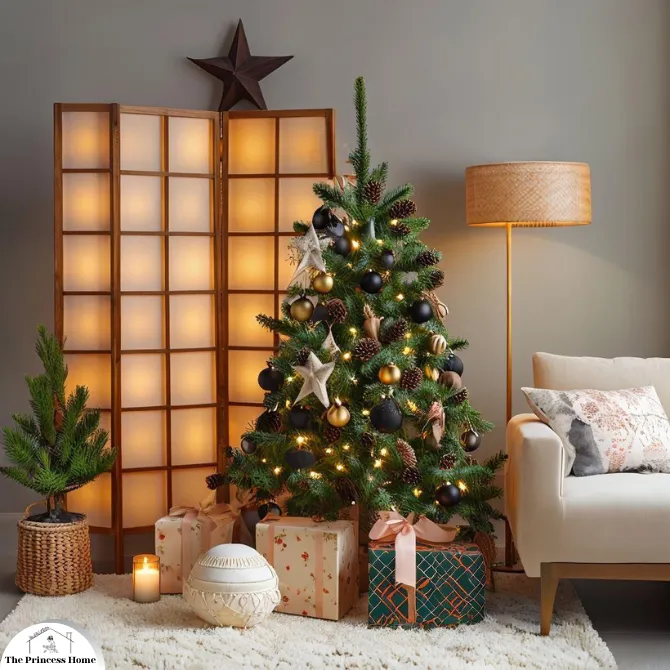
8. Shoji Screen-Inspired Wall Decor
Shoji screens are Japanese room dividers made with wooden frames and translucent paper, adding a soft and warm glow to spaces. Bring a touch of this style into your holiday decorations.
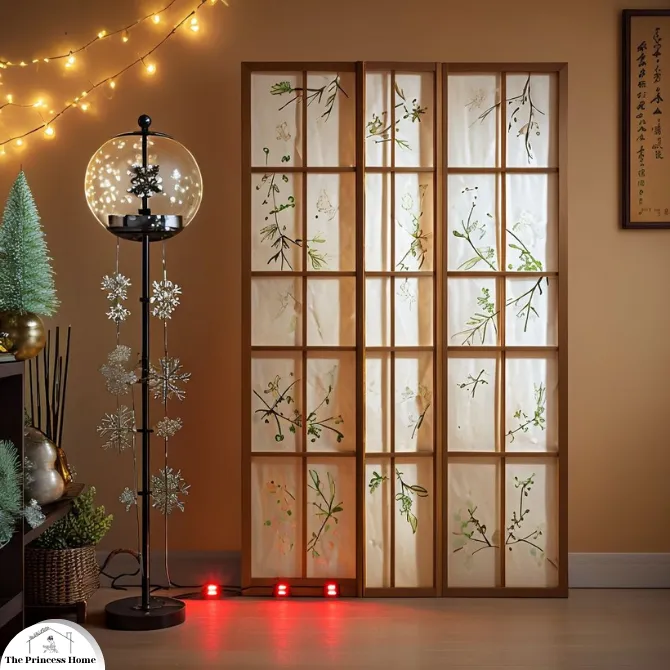
Christmas Shoji Panels:
Create small wall panels using wood frames and parchment paper, then paint or stencil on Christmas motifs.
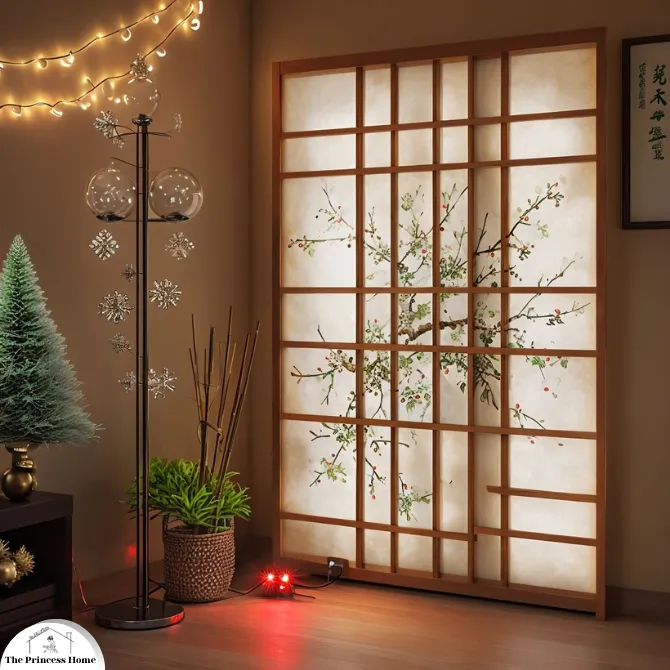
Backlighting for Ambiance:
Hang a string of lights behind these panels to mimic the soft, diffused light of a shoji screen.
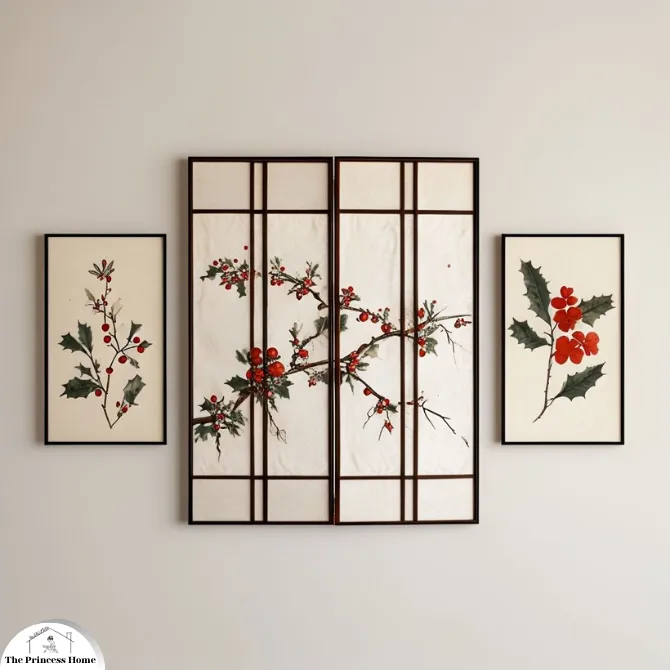
Framed Artwork:
If you prefer a simpler look, frame individual panels of parchment with subtle Christmas designs like holly or snowflakes, creating wall art with a Japanese influence.
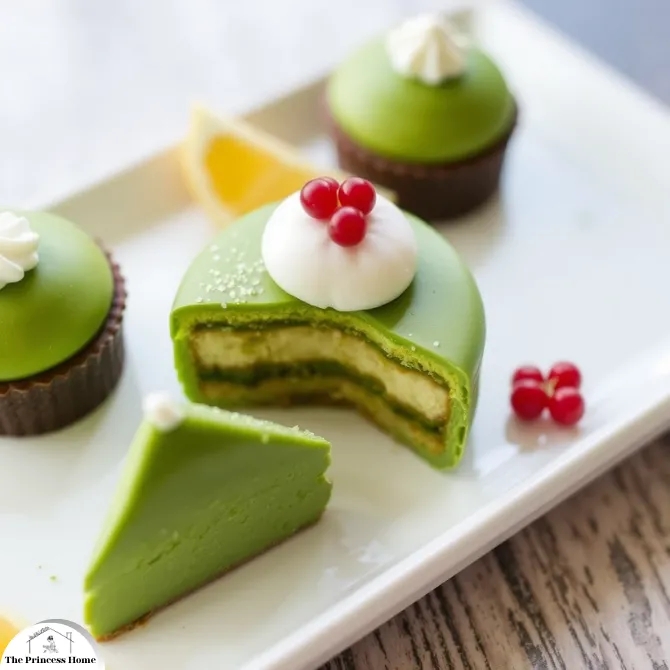
9. Matcha and Yuzu Holiday Treats
Incorporate traditional Japanese flavors like matcha (green tea) and yuzu (a citrus fruit) into your holiday treats for an elegant twist on Christmas desserts.
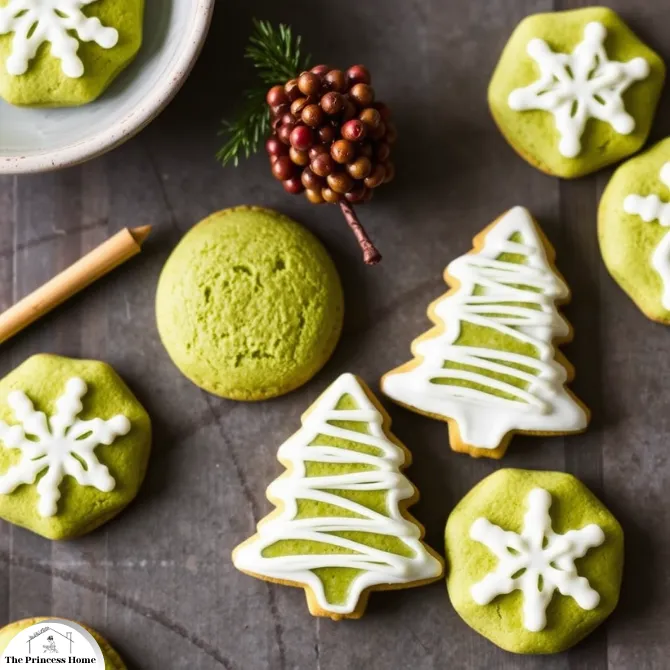
Matcha Cookies:
Bake cookies with matcha powder for a vibrant green hue, ideal for holiday spreads. Decorate them with white icing for a snowy effect.
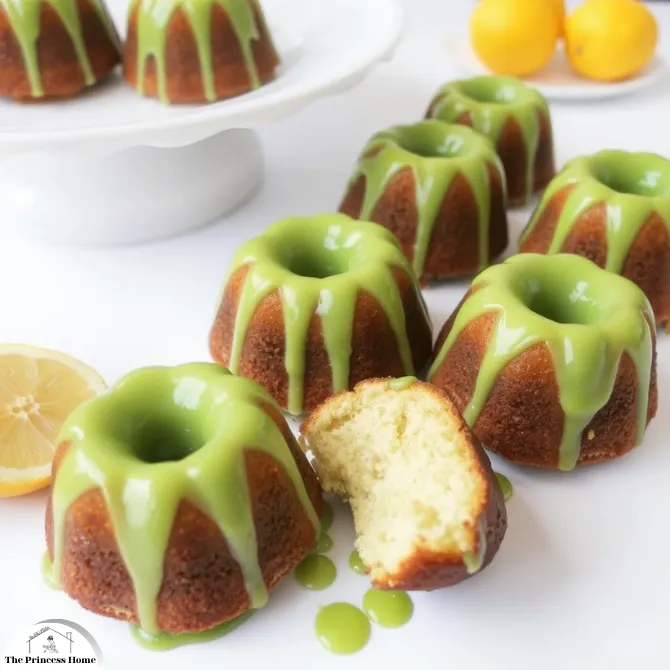
Yuzu Glazed Cakes:
Prepare mini Bundt cakes with a yuzu glaze to add a refreshing citrus twist to your holiday dessert table.
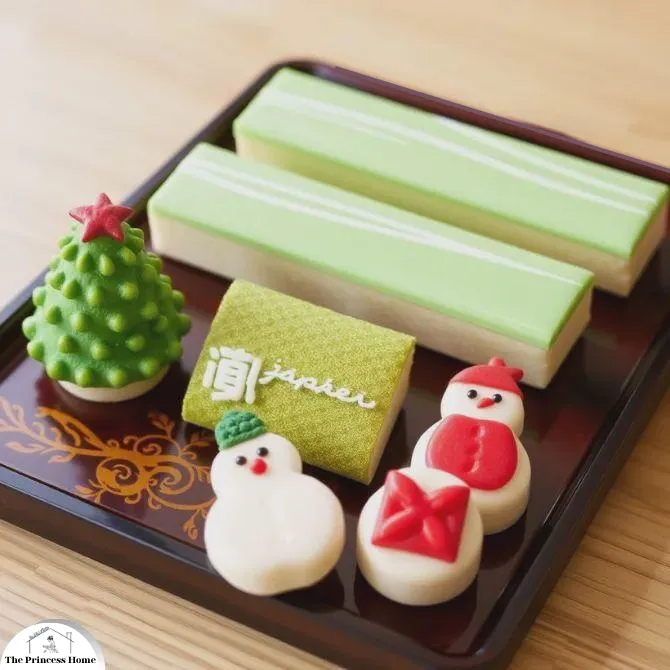
Japanese Sweets Display:
Present treats on a Japanese-style lacquered tray or arrange wagashi (Japanese sweets) in Christmas shapes, such as Christmas trees or snowmen, for a dessert display that’s as beautiful as it is delicious.
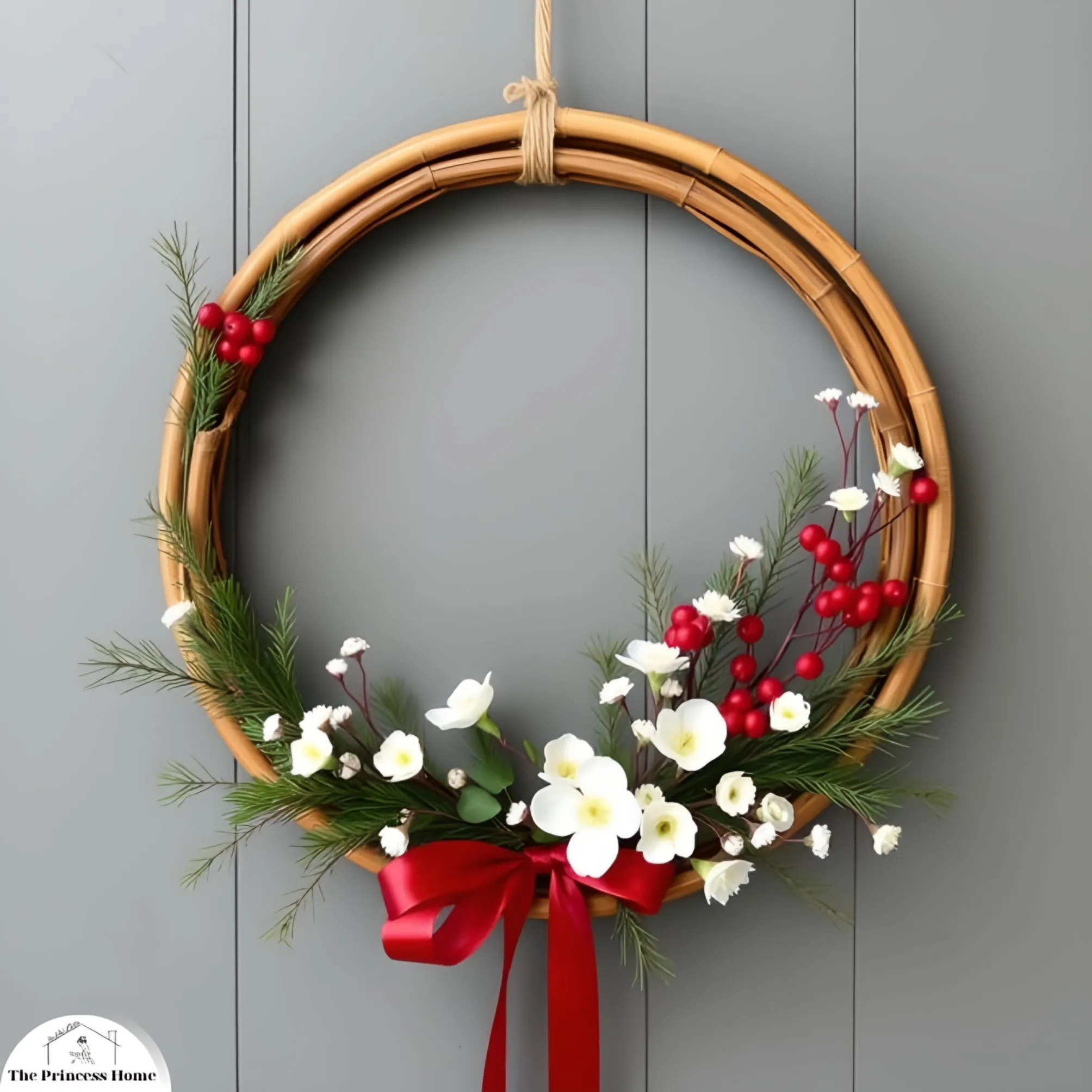
10. Zen Christmas Wreath
Create a Zen-inspired wreath that incorporates Japanese aesthetics with natural holiday elements Use a bamboo or willow ring as a base for your wreath. Bamboo represents resilience and strength, making it a meaningful addition to your holiday decor.
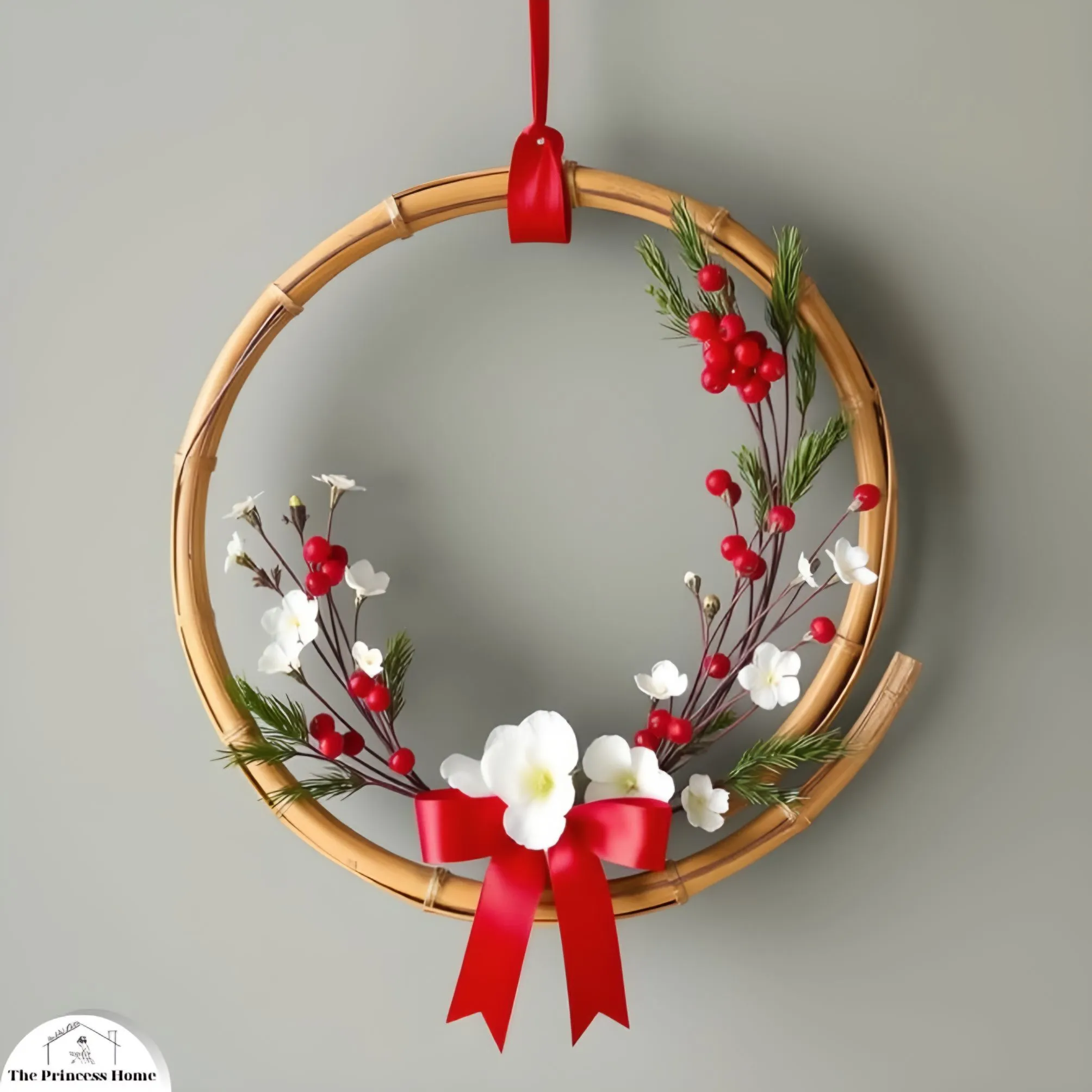
Simple Adornments:
Use subtle, natural elements like pine sprigs, holly berries, and delicate white flowers instead of a dense wreath. The minimalist design is calming and beautiful.
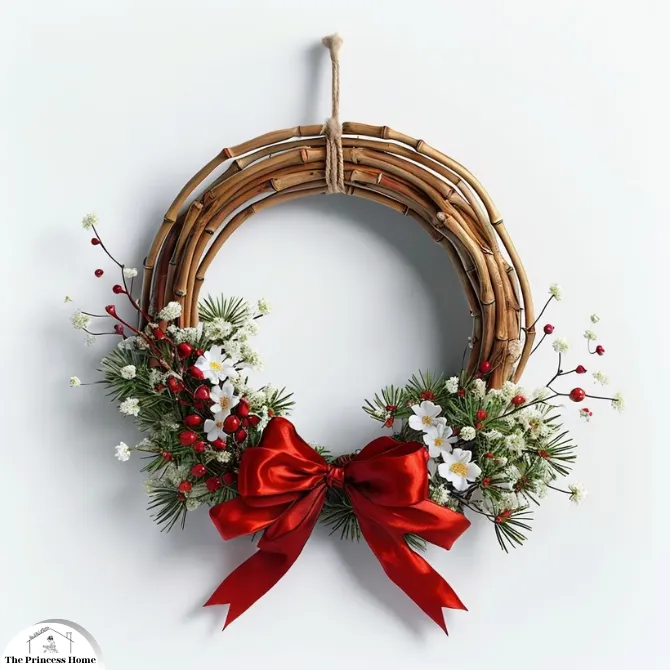
Seasonal Touches:
For a festive finish, add red or gold ribbon sparingly, allowing the natural elements to remain the focus.
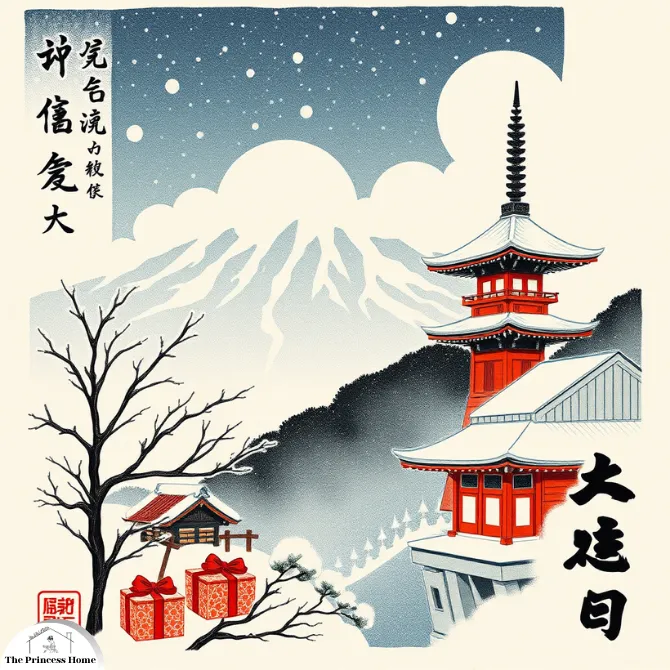
11. Japanese Calligraphy Christmas Art
Integrate Japanese calligraphy as unique wall art or gift tags.
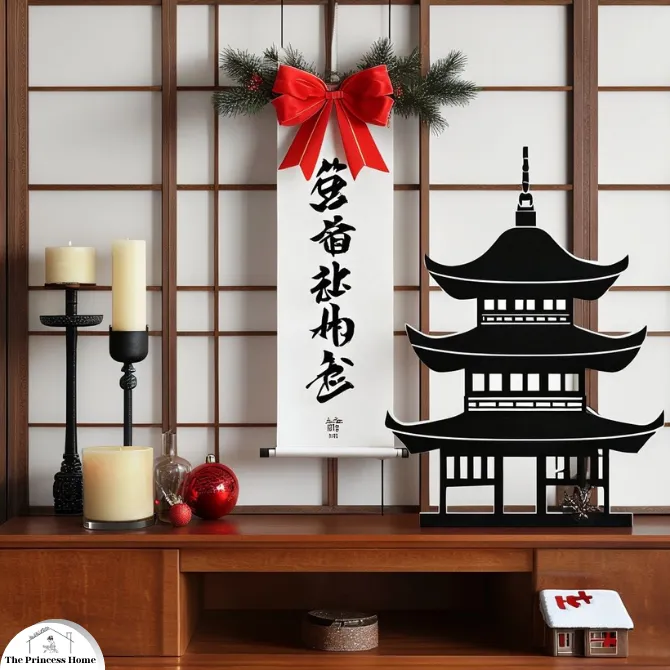
Seasonal Calligraphy:
Use kanji characters that represent positive themes like “Joy” (喜), “Peace” (平和), or “Love” (愛) to add meaningful elements to your holiday decor.
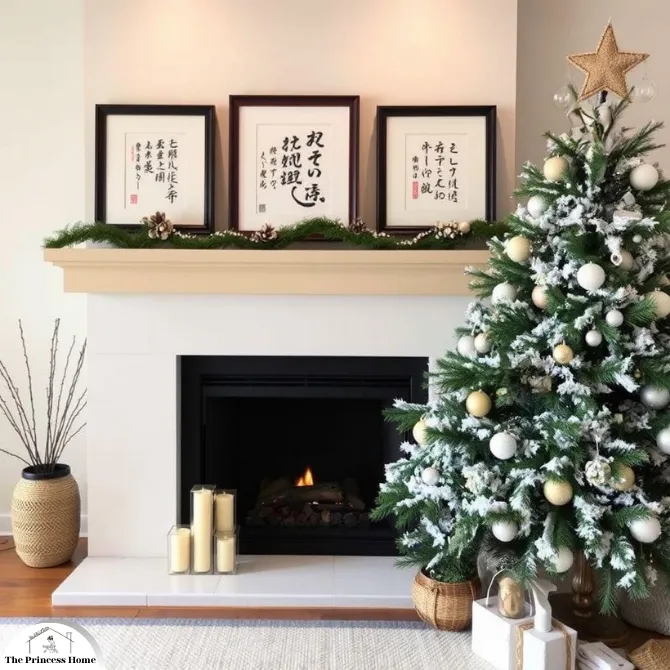
Brushstroke Art:
Place simple calligraphy pieces framed above the fireplace, or on the wall by the tree, for an understated yet elegant touch.
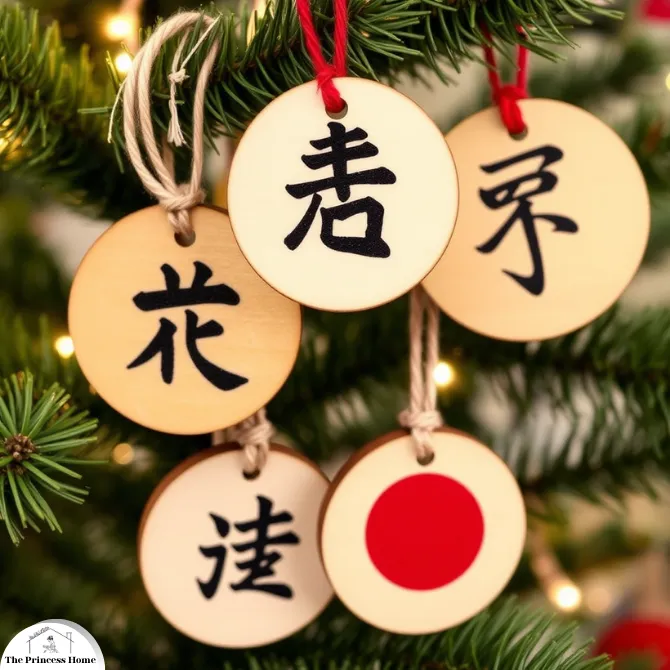
Personalized Ornaments:
Paint kanji characters on small wooden ornaments for personalized, symbolic decorations that add depth to your Christmas tree.
Conclusion
By incorporating these Japanese-inspired touches into your Christmas decorations, you can create a holiday environment that is both tranquil and festive, blending the beauty of Japanese artistry with the warmth of the Christmas season. This fusion of cultures brings a fresh, harmonious look to traditional holiday decor, creating a unique and memorable atmosphere for you and your guests to enjoy.
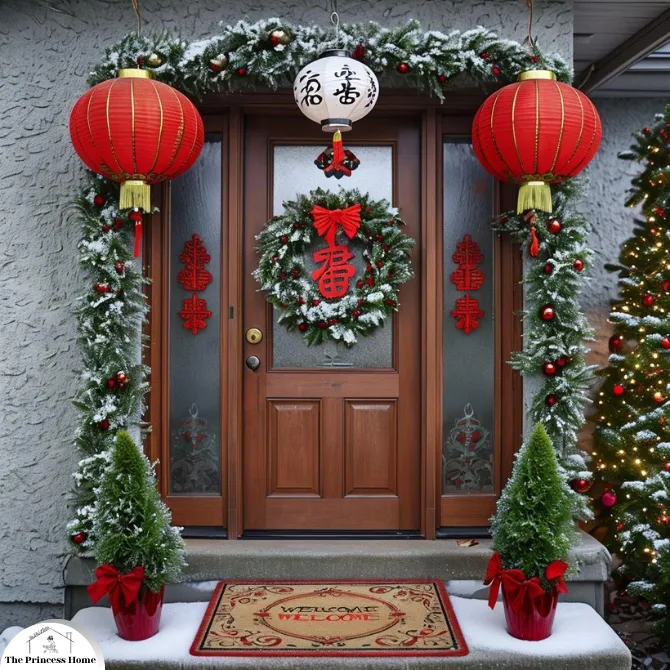
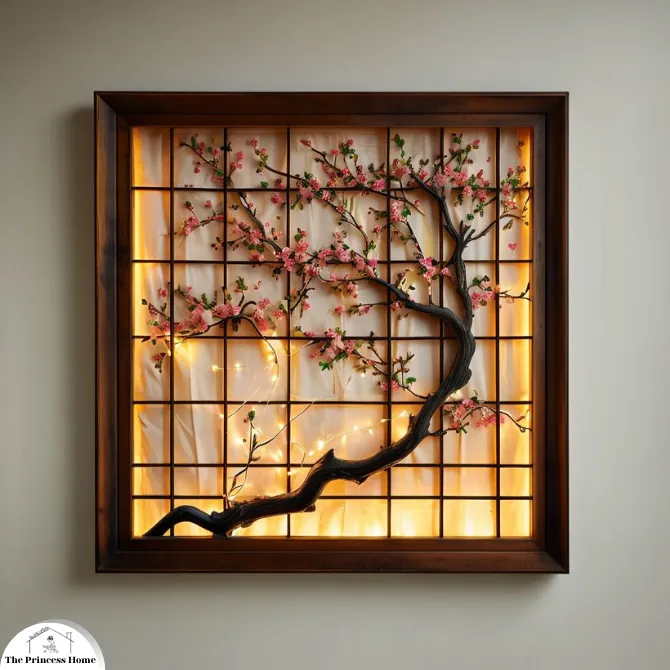
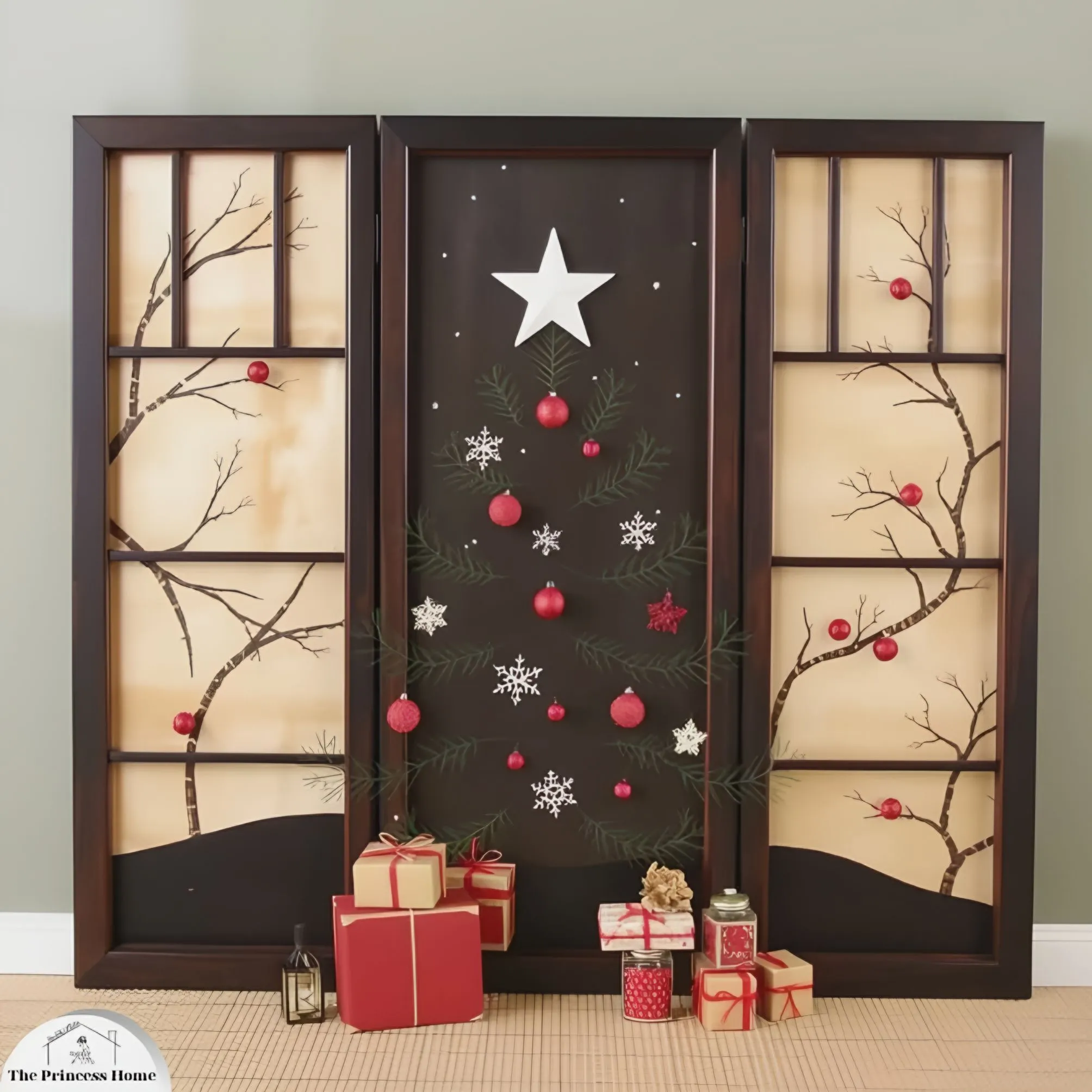
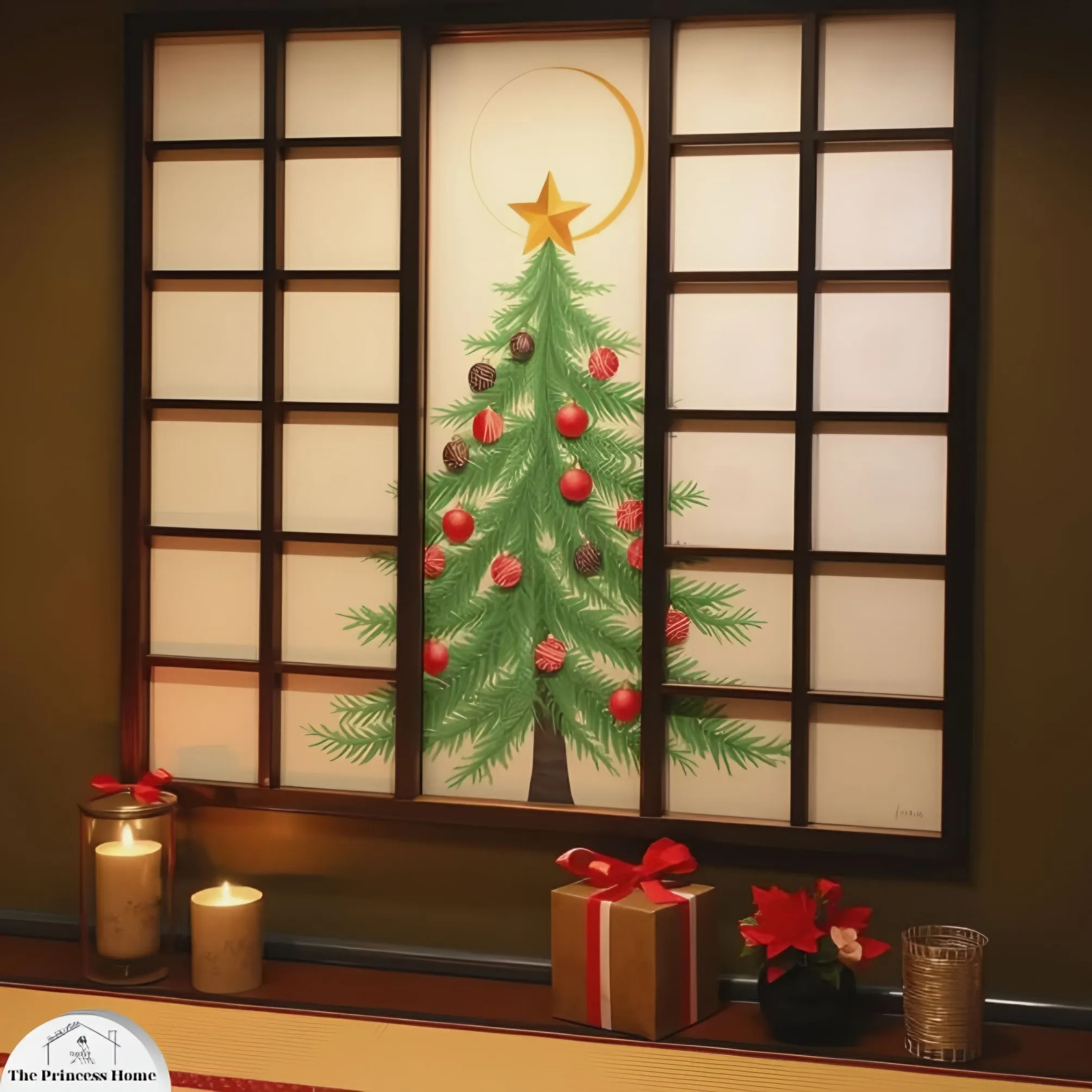
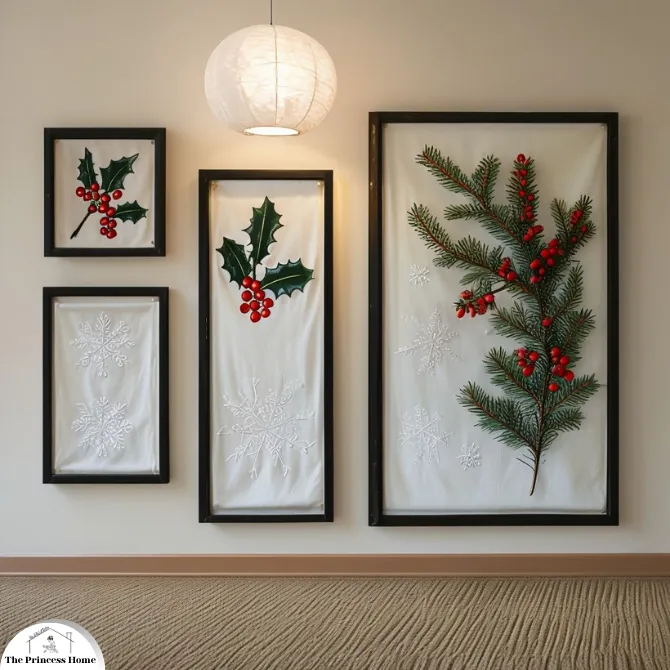
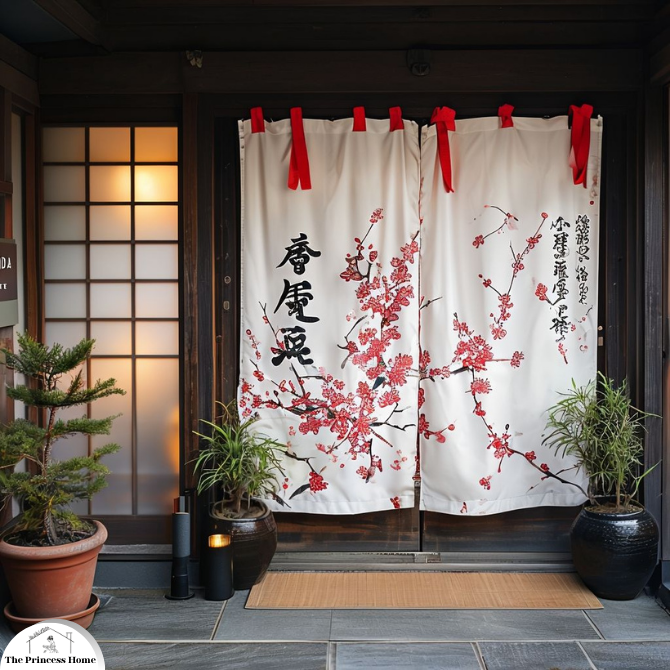
Here are some frequently asked questions about incorporating Japanese elements into Christmas decorations, along with answers that can enhance holiday decor with elegance and cultural depth.
Here are some frequently asked questions related to the article :
1. What are some popular Japanese motifs for Christmas decorations?
In Japanese decor, seasonal motifs like pine, bamboo, plum blossoms, and cranes are popular symbols of longevity, resilience, and good fortune. You can incorporate these designs on ornaments, wreaths, and table settings for an elegant, meaningful touch. Additionally, kintsugi (the art of repairing broken pottery with gold) can inspire ornaments that celebrate beauty in imperfection.
2. How can I make origami ornaments for my Christmas tree?
Origami ornaments, like cranes, stars, and flowers, are both decorative and symbolic. Choose high-quality Japanese washi paper in holiday colors such as red, white, and gold. Once folded, string the origami shapes with delicate threads or ribbon to hang on the tree. For extra sparkle, consider dusting them with gold or silver glitter.
3. What types of Japanese flowers can be used for Christmas floral arrangements?
Camellias, chrysanthemums, and red peonies are often used in Japanese floral arrangements. These flowers add elegance and seasonal color to the decor. You could arrange them in a wabi-sabi style, which celebrates simplicity, with branches, berries, and greenery to capture a natural, serene feel.
4. Can I incorporate Japanese tableware in my Christmas dinner setup?
Japanese ceramics and lacquerware are a beautiful addition to Christmas tablescapes. Small lacquer boxes, bowls, and chopstick rests in holiday hues or metallic accents add sophistication. Try pairing traditional Western dinnerware with Japanese shibori (tie-dye) napkins or bamboo chopsticks for a unique, mixed-culture aesthetic.
5. What Japanese techniques can add a unique touch to gift wrapping?
Furoshiki, the Japanese art of wrapping items with cloth, is perfect for a sustainable and unique wrapping style. Use festive or patterned fabrics to wrap gifts, tying the corners into decorative knots. This approach can replace traditional wrapping paper and create beautifully packaged presents, adding an eco-friendly touch to your holiday gifts.
6. How can I create a Japanese-style wreath for Christmas?
Japanese wreaths often use pine, bamboo, and paper fans, symbolizing longevity and strength. Arrange these elements on a minimalist hoop or wreath base, accented with small pine cones, berries, and ribbons in red or gold. For a finishing touch, add a mizuhiki knot, a traditional Japanese decorative knot, symbolizing harmony and unity.
7. Are there any Japanese holiday symbols that are appropriate for Christmas decor?
The Japanese kadomatsu, traditionally displayed during the New Year, is often made with pine, bamboo, and plum branches, symbolizing resilience, strength, and renewal. Adapted for Christmas, a mini kadomatsu could serve as a festive table centerpiece or an entryway decoration, reflecting the spirit of hope and new beginnings.
8. What are some ideas for Japanese-inspired holiday lights?
Instead of standard string lights, consider incorporating paper lanterns or small hanging chochin lanterns as decorative accents. These can be used on the Christmas tree or around the home to create a warm, soft glow reminiscent of traditional Japanese lighting. Red and white lanterns also fit perfectly with Christmas colors and themes.
9. How can I use Japanese textiles in my holiday decor?
Japanese kimono fabric or washi paper with floral, fan, or nature motifs can be used as table runners, napkin rings, or even wall hangings. You could also create small fabric ornaments or use obi (kimono belts) to tie around Christmas stockings or decorative cushions, introducing a unique and luxurious touch.
10. Is there a Japanese tradition of exchanging small gifts that could be adapted for Christmas?
The Japanese practice of omiyage (giving souvenirs or small gifts) can be adapted to Christmas by creating small, thoughtful bundles or packages. Consider packaging small treats or trinkets in decorated sachets or using beautiful Japanese envelopes (pochibukuro) with festive designs to give to friends and family, adding a personalized and heartfelt element to gift exchanges.







